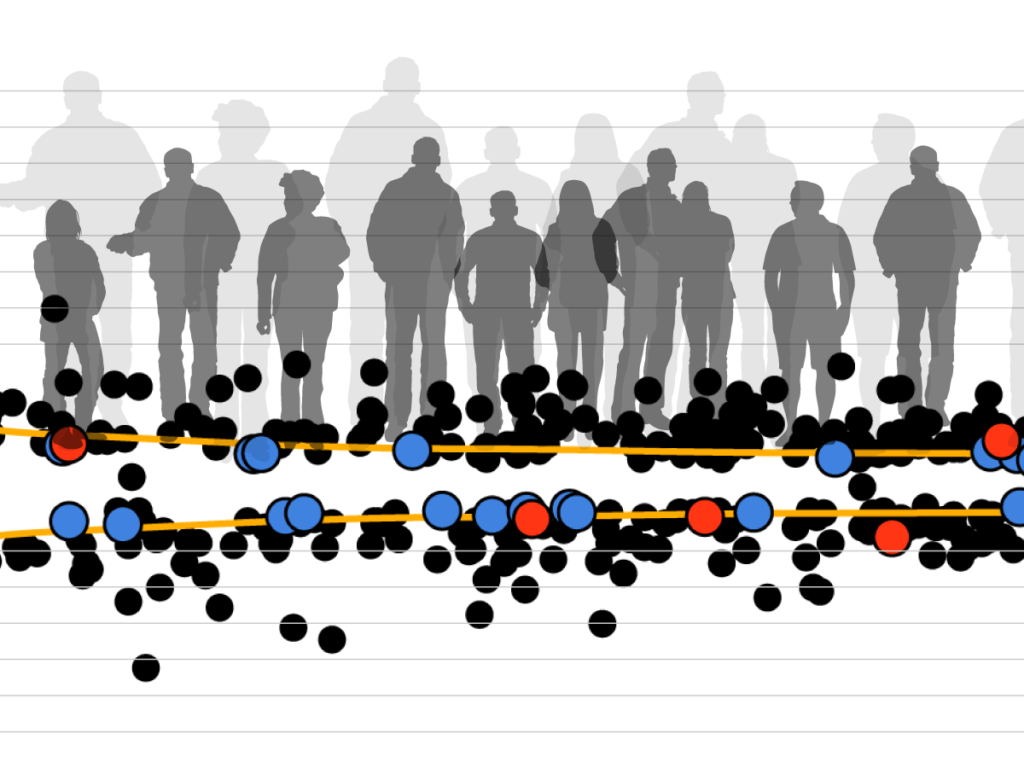Why I’m tall and you’re short: GIANT effort finds rare, potent height genes

Height is the “poster child” of complex genetic traits, meaning that it’s influenced by multiple genetic variants working together. Because height is easy to measure, it’s a relatively simple model for understanding traits produced by not one gene, but many.
“Mastering the complex genetics of height may give us a blueprint for studying multifactorial disorders that have eluded our complete understanding, such as diabetes and heart disease,” says Joel Hirschhorn, MD, PhD, a pediatric endocrinologist and researcher at Boston Children’s Hospital and the Broad Institute of MIT and Harvard.
Hirschhorn chairs the Genetic Investigation of Anthropometric Traits (GIANT) Consortium, an international group that’s just probed more deeply into the genetics of height than ever before. Its findings, reported today in Nature, reveal previously unknown biological pathways tied to height.
Height genes, 1.0
Finding height genes means doing massive comparisons of people of varying heights.
In 2014, GIANT gathered roughly 250,000 people and performed a genome-wide association study (GWAS), which rapidly scans across a population’s genomes to find markers that track with a particular trait. That effort brought the number of known genetic variants influencing height to nearly 700 — in more than 400 spots in the genome — explaining about 20 percent of the heritability of height.

The variants found through these and earlier efforts are common ones with small effects, altering height by less than 1 mm (south of 1/20 of an inch). Because of the nature of GWAS studies, they also tend to lie outside the protein-coding parts of genes, making it harder to figure out which genes and proteins are actually altering height.
So the GIANT investigators took another dive.
“This time we went for low-frequency and rare changes that directly alter proteins and tend to have stronger effects,” says Hirschhorn, co-senior investigator on the study together with researchers at the Montreal Heart Institute, Queen Mary University, the University of Exeter, UK, and nearly 280 other research groups. “That required tremendous statistical power, which we achieved thanks to a strong international collaboration.”
Height genes, 2.0
The new study amassed more than 700,000 adults: an initial 460,000 people and about 250,000 more to validate the findings. It also applied a new technology: an exome chip that enabled GIANT to test for a catalogue of nearly 200,000 known but uncommon variants that alter the function of protein-coding genes. Most hadn’t been assessed in prior genetic studies of height.
“These variants point more directly to genes, and can be used as a shortcut to figuring out which genes are important for a specific disease or trait,” says Hirschhorn.
The search uncovered 83 new variants: 51 “low-frequency” variants (found in less than 5 percent of people) and 32 rare variants (found in less than 0.5 percent). Their effect was more potent than those of the previously discovered variants: 24 altered height by more than 1 cm (4/10 of an inch), and a few by more than 2 cm (almost 8/10 of an inch).
In fact, as the graph below shows, the genetic variants that increased or decreased height the most (1 to 2 cm) were also the rarest, with a population frequency (called MAF on the graph) of less than 5 percent. “This finding matches a pattern seen in other genetic studies, where the more potent variants are rarer in the population,” notes Hirschhorn.

Key height influencers
The new variants pointed to dozens of genes that appear important for skeletal growth. Some of these genes were already known, but many (like SUSD5, GLT8D2, LOXL4, FIBIN and SFRP4) hadn’t previously been connected with skeletal growth.
One gene of particular interest to the GIANT investigators, STC2, had two different highly rare variants (each with a frequency of 0.1 percent). One can be seen at the far upper left of the above diagram. People with either of these changes were 1 to 2 cm taller than non-carriers. Further investigations by GIANT members at Aarhus University in Denmark suggested that the variants influence height by affecting the availability of growth factors in the blood. “The STC2 protein serves as a brake on human height, validating it as a potential drug target for short stature,” says Hirschhorn.
The heat map below gets at some of the shared biological connections of the height-associated genes. The redder squares indicate stronger connections between a given gene (listed along the bottom) and its predicted biological function (listed along the right).

Height genes, 3.0
With the new findings, 27.4 percent of the heritability of height is now accounted for (up from 20 percent). That still leaves more than 70 percent, so the GIANT Consortium’s work detailing the genetic “architecture” of height isn’t yet done.
“Even larger sample sizes will be needed to completely understand the genetic and biologic basis of human growth and multifactorial diseases,” says Hirschhorn.
Indeed, GIANT is already embarking on a GWAS of height with more than 2 million people, and other studies involving sequencing data are underway, he says.
Related Posts :
-

New research sheds light on the genetic roots of amblyopia
For decades, amblyopia has been considered a disorder primarily caused by abnormal visual experiences early in life. But new research ...
-

New genetic insights could change how we treat, and talk about, polycystic ovary syndrome
Polycystic ovary syndrome (PCOS) has long been viewed as a hormonal disorder affecting women of reproductive age. However, ongoing research ...
-

Thanks to Carter and his family, people are talking about spastic paraplegia
Nine-year-old Carter may be the most devoted — and popular — sports fan in his Connecticut town. “He loves all sports,” ...
-

Genetic causes of congenital diarrhea and enteropathy come into focus
Congenital diarrheas and enteropathies are rare and devastating for infants and children. Treatments have consisted mainly of fluid and nutritional ...





